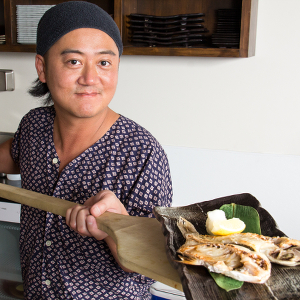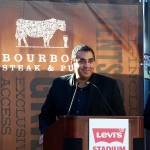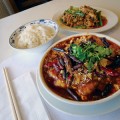It’s a new eatery, but Iroriya draws on a traditional Japanese technique that goes back to meals cooked hearthside, over open fires. The restaurant specializes in Robatayaki, a style in which the food (mostly fish and veggies) is grilled over charcoal—and sometimes hay—on skewers. There is no hay stoking the grill at Iroriya, but the restaurant’s Robatayaki dishes are indeed cooked over a charcoal grill.
Iroriya is under the same ownership of the incredibly popular Orenchi Ramen next door—where there is always a line. Yoshiyuki Maruyama opened Iroriya a few months ago. SanJose.com asked him about his new restaurant and old-school techniques.
SanJose.com: Can you explain robatayaki cooking style?
Maruyama: Robatayaki goes back to the olden days where there was no gas or electricity in the house. They used to have a square in the middle of the house where they put coals and they used to sit around that square and they’d put the fish on a stick and let it grill over the charcoal. They’d use hay to add more smoky flavor to the food. But we’re not allowed to do that here, so we don’t. We try to make it as traditional as we can.
What would someone order if they wanted an authentic Robatayaki dining experience?
I would recommend the himono (dried fish). We marinate the fish, and sun-dry it on the roof here for about a day. When we grill it, it’ll make the skin a little crisp, and the inside very moist. We take the whole fish and we take out the innards, put it on the skewer, salt it then just grill it. Depending on what marinade we use, the salt water or the sweet soy sauce, it changes the flavor of the fish.
Tell me about kamameshi, a rice dish that’s cooked in a kettle.
It’s a braised rice dish. This is also how it was made in the olden days without gas. It’s a steel pot. We put the rice and the dashi [clear Japanese soup stock] inside and with seasonal ingredients. Then we put a lid over it and light it on fire. It’s made in the kitchen with the regular gas. It would take way too long on the charcoal grill. Then we let it sit so it can soak up the rest of the dashi. Then the server will bring it to your table and take off the lid. They’ll mix it right in front of you and serve it for you. It’s very moist, but it’s not like a risotto. For the fall we did chicken, mushroom and carrots. It changes seasonally. It’s going to be a little more seafood for the winter.
You serve Jaga Bata Shiokara, which is fermented squid legs, right?
It’s basically a whole potato. We’ll grill it on the charcoal and then we’ll put butter on it, then we’ll put the shiokara on top. Shiokara itself is very smelly and very raw. It’s marinated in its own squid innards and it’s flavored with salt. It’s very fishy, but with the potato and the butter it mellows out the fishiness. The potato we’ll cook on the grill. The shiokara, we can’t cook it. It’s just raw marinated. We just put that on top of the potato.

 Michael Mina to Open New Restaurants at 49ers Stadium
Michael Mina to Open New Restaurants at 49ers Stadium  Michelin-starred Chef to Open New Restaurant at Pruneyard
Michelin-starred Chef to Open New Restaurant at Pruneyard 


